#173: Lepiotoid Mushrooms
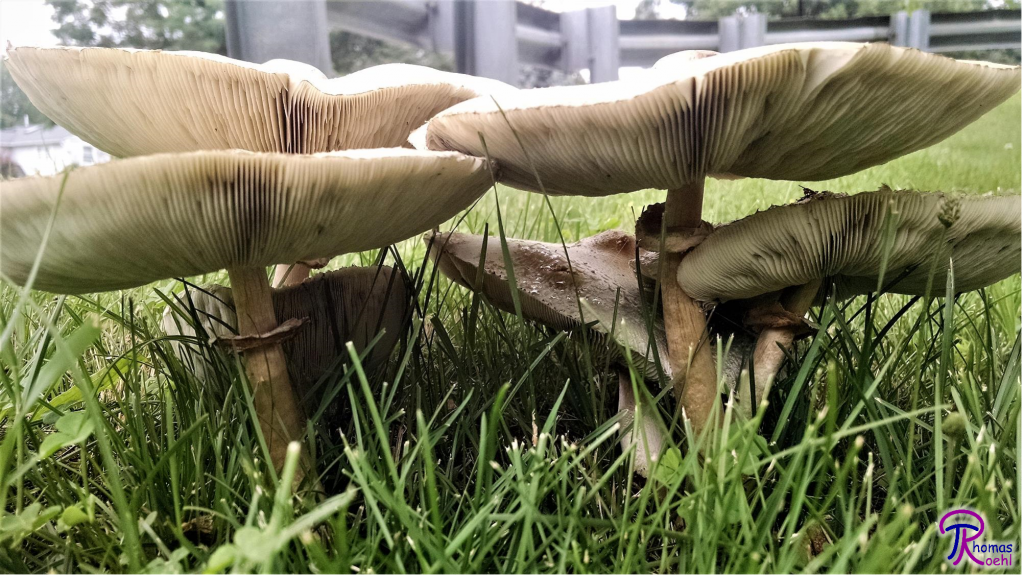
Lepiotoid mushrooms, such as this Macrolepiota sp., have free gills, a partial veil, and a white spore print.
The lepiotoid mushrooms are a genetically diverse group but are often lumped together in field guides to simplify identification. Morphologically, lepiotoid mushrooms most closely resemble mushrooms from the genus Amanita (FFF#172). Lepiotoid mushrooms have free gills, a white spore print, and a partial veil, but are saprobic and lack a universal veil. Despite these shared characteristics, lepiotoid mushrooms have multiple origins. “Lepiotoid” means “like Lepiota.” Most lepiotoid mushrooms were at one time placed in the genus Lepiota, so that genus is used as a basis for this morphological group.1
Description
Like the amanitas, the lepiotoid mushrooms are agarics with a central stipe and a circular pileus. These mushrooms are generally smaller and thinner than the amanitas, so they are sometimes called “parasol mushrooms.”2
The most important feature of the lepiotoid group is the white spore print. All lepiotoid mushrooms have a white spore print, except for the green-spored Chlorophyllum species.1,2 The white spore print is really the defining feature of the group. Many lepiotoid genera have the prefix Leuco– in their name, such as Leucoagaricus. Leuco– means “white”3 and when used in a genus name it usually refers to the spores. Consequently, Leucoagaricus describes a genus of white-spored mushrooms that otherwise look like mushrooms from the (dark-spored) genus Agaricus.
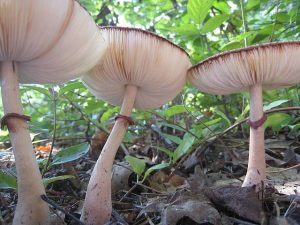
From this angle, you can clearly see the ring and free gills of Leucoagaricus amaricanus. Photo by Amanita77 [CC BY-SA 3.0], via Wikimedia Commons
An alternate and more accurate method for estimating spore print color is by looking for spores collecting on nearby surfaces. Leaves or other mushrooms that stick up underneath the mushroom are great places to look. If the mushroom has a ring, collected spores can often be found on the top of the ring. These natural spore prints are very handy, but they rarely form.
Another feature that distinguishes the lepiotoid mushrooms is their free gills. This means that the gills radiate out from the stipe but never quite touch the stipe.1,2 In some lepiotoid mushrooms the gills clearly leave a space around the stipe while others get much closer. Sometimes it can be hard to verify whether a mushroom has free gills and it may come down to a judgment call whether the gills are “free” or “narrowly attached.”
Lepiotoid mushrooms also produce a partial veil. The partial veil is a membrane that protects the developing gills as the mushroom grows. Once the gills are ready to produce spores, the partial veil breaks away. This often leaves evidence hanging around the stipe or along the pileus margin. Remnants around the stipe are called a “ring” or “annulus” and are commonly found in the lepiotoid mushrooms. However, these remains are very fragile and the ring can easily disappear completely or be lost during transport.1,2,4
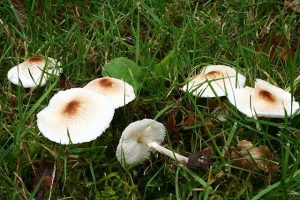
The brown squamules on Lepiota cristata are attached to the pileus. Photo by Strobilomyces (Own work (Own photo)) [GFDL, CC-BY-SA-3.0 or CC BY-SA 2.5-2.0-1.0], via Wikimedia Commons
Finally, most lepiotoid mushrooms are saprobic, meaning they decompose dead organic matter. Consequently, lepiotoid mushrooms usually grow in places such as: mulch, leaf litter, and large patches of grass. Amanita species, on the other hand, are usually mycorrhizal and grow from the soil under trees.1
If you still can’t tell whether you’ve picked an Amanita or lepiotoid mushroom, there is one last thing you can check. Take a thin slice of gill tissue (cut perpendicular to the gill face from top to bottom so that it makes a tall V shape) and examine it under a microscope. Lepiotoid mushrooms have disorganized hyphae in the center of their gills, while amanitas have hyphae that point down and out from the middle.2
Edibility
Within the lepiotoid mushrooms, edibility is a mixed bag. The group contains good edibles such as Macrolepiota procera, mushrooms with gastrointestinal irritants such as Chlorophyllum molybdites, and amatoxin-containing mushrooms such as Lepiota castanea (see FFF#091 for more on the deadly amatoxins).2 Because lepiotoid mushrooms have many look-alikes and are difficult to identify down to species,1 I recommend you avoid eating lepiotoid mushrooms. If you choose to eat them, make sure you are well acquainted with the edible lepiotoid mushrooms in your area and with all possible look-alikes.
Taxonomy
Mycologists are still sorting out the genetic relationships of the lepiotoid mushrooms. All lepiotoid mushrooms belong to the family Agaricaceae, but they do not form a distinct lineage within that family. For example, a 2011 paper published in Mycologia produced a phylogeny that had Chlorophyllum (green-spored) most closely related to Agaricus (brown-spored), Macrolepiota (white-spored, lepiotoid) most closely related to Lycoperdon (dark-spored, puffball), and Lepiota species scattered all over the place (though a few did sort out into a distinct lineage).5 Despite this, field guides often still group the white-spored Agaricaceae species together because it makes the Agaricaceae easier to key out.
| Kingdom | Fungi |
| Phylum | Basidiomycota |
| Subphylum | Agaricomycotina |
| Class | Agaricomycetes |
| Subclass | Agaricomycetidae |
| Order | Agaricales |
| Family | Agaricaceae Chevall.6 |
This post describes a group of mushrooms and as such the information on this page (including the pictures) cannot be used to identify any mushroom in particular.
This post does not contain enough information to positively identify any mushroom. When collecting for the table, always use a local field guide to identify your mushrooms down to species. If you need a quality, free field guide to North American mushrooms, I recommend Michael Kuo’s MushroomExpert.com. Remember: when in doubt, throw it out!
See Further:
http://www.mushroomexpert.com/lepiotoid.html
Citations
- Michael Kuo. Lepiotoid Mushrooms. MushroomExpert.Com (2015). Available at: http://www.mushroomexpert.com/lepiotoid.html. (Accessed: 13th January 2017)
- Miller, O. K. & Miller, H. North American mushrooms: a field guide to edible and inedible fungi. (Falcon Guide, 2006).
- leuco-. Wiktionary Available at: https://en.wiktionary.org/wiki/leuco-. (Accessed: 13th January 2017)
- Michael Kuo. Glossary of Mycological Terms. MushroomExpert.Com (2006). Available at: http://www.mushroomexpert.com/glossary.html. (Accessed: 6th January 2017)
- Vellinga, E. C., Sysouphanthong, P. & Hyde, K. D. The family Agaricaceae: phylogenies and two new white-spored genera. Mycologia 103, 494–509 (2011).
- Agaricaceae. Mycobank Available at: http://www.mycobank.org/BioloMICS.aspx?Table=Mycobank&Rec=58983&Fields=All. (Accessed: 13th January 2017)


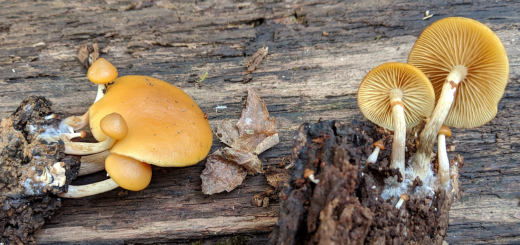
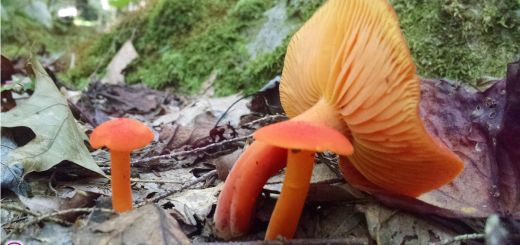





![#011: Characteristics of Kingdom Fungi [Archived]](https://www.fungusfactfriday.com/wp-content/themes/hueman/assets/front/img/thumb-small-empty.png)

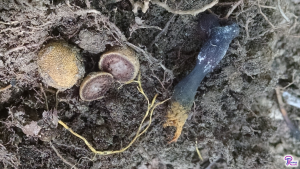
3 Responses
[…] hinted at by its common names, C. molybdites is a lepiotoid mushroom (FFF#???): it has a circular pileus, a central stipe, free gills, and a partial veil. C. molybdites is large […]
[…] Lepiotoid10,11 […]
[…] is most closely related to the lepiotoid mushrooms (FFF#173), even though they have white spores.6 Spore print, although useful for identifying mushrooms, does […]